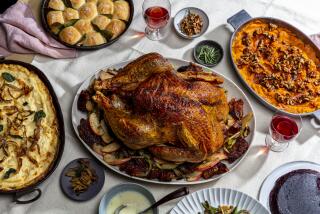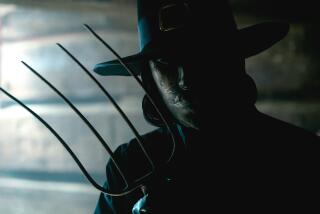‘Squanto’ Makes History by Putting Adventure Ahead of Thanksgiving
- Share via
In “Squanto: A Warrior’s Tale,” two Native Americans, trapped and displayed as savages in England by 17th-Century traders, manage to return to their villages. One seeks revenge on the colonists. The other, peace. (Rated PG)
*
A Walt Disney production, “Squanto” harks back to the Disney of memory--a little swashbuckling adventure, a little history, a dash of evil, a larger dash of good and some gentle humor involving jolly friars. In other words, it’s a movie parents can watch with their kids and not zone out on completely--or feel as if they have to cover their little ones’ eyes.
If parents or teachers want to use it as a Thanksgiving history lesson, the kids probably won’t mind.
“I liked it,” said Cliff Taylor, 7. “It was almost a true story. Or, probably true.”
Or, let’s just say, at least true enough to make history come alive for kids who dozed through class.
“It was interesting. It seems like it came right out of the history book,” Noah Vidal, 12, said, as if that were a good thing. He admitted studying that period in history a couple years ago, but back then, he said, “It didn’t mean that much.”
One thing he learned from the movie was that Native Americans “are smarter than you think.”
Nick Taylor, who put his age at 4 3/4, agreed.
“Squanto really seemed smart,” he said, remembering how the character freed himself from his English cell by luring mice to gnaw on bonds that he had dipped in mush.
Squanto also makes fire by friction and clothing from animal skins. He soothes an angry bear with a lullaby. He learns English with remarkable speed. While his fellow Native American Epenow remains enslaved in Plymouth by the traders, Squanto escapes and is harbored by a group of cloistered priests. From them, he learns about books, all written and illustrated by hand, and that not all whites are greedy and ignorant.
It was also a friar who helped him flee the traders and catch a ship home.
By movie’s end, he has practically become the Gandhi of the Northeast.
It is as a result of his peacemaking efforts that the colonists and the Native Americans sit down and share the first Thanksgiving turkey. It’s a scene that Noah said might change his view of the holiday.
“It took a while for them to be friends and to see each other as equals,” he said. Maybe the Native Americans were more grateful for the harvest than the colonists, he added. “These guys worked for it.”
The story is told from Squanto’s point of view, portraying the English largely as insensitive bearers of new diseases and often hypocritical about their beliefs on tolerance. Native Americans come across as gentle, cultured and dignified.
Noah said he also learned how Native Americans valued all animal life and the land. “They thought they had a great life,” he said. “And they did.”
The kids also found the film exciting and fun. Cliff’s favorite scene was a horse chase through Plymouth that ended in a thrilling leap from dock to sailing ship.
Noah liked a fight between Squanto and the bear, staged for the English townsfolk like the Romans staged fights between lions and Christians.
Despite the history, Noah said, “There was adventure in there. It wasn’t boring.”
More to Read
Only good movies
Get the Indie Focus newsletter, Mark Olsen's weekly guide to the world of cinema.
You may occasionally receive promotional content from the Los Angeles Times.










